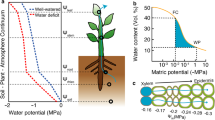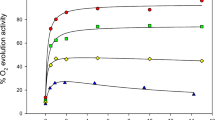Summary
The phosphate uptake in the leaf cells of Elodea densa shows multiple isotherms in the range [S]>1 mmole P/l to 100 mmoles P/l. In the dark the uptake isotherms contain three distinct parts (II/1, II/2 and II/3); the first two obey Michaelis-Menten kinetics, whereas the third is exponential. In the light the phosphate uptake curve consists only of two parts (II/1 and II/2) agreeing with Michaelis-Menten kinetics, the exponential part being absent.
Cellular phosphate content was found to be 45 mmoles/l. Data concerning the membrane potential E for Elodea densa were obtained from Jeschke (1970). In accordance with the Nernst equation a change from the hyperbolic curve to an exponential one was expected at a concentration of about 60 mmoles P/l in the dark and at above 100 mmoles P/l in the light. The results obtained agree with these theoretical calculations: in the dark, the change from the hyperbolic to the exponential curve was observed at [S]=50 mmoles P/l, which is in electro-chemical equilibrium with the cellular orthophosphate content of about 35 mmoles/l (inorganic P content amounting to 80 per cent of total phosphate). In the light no change towards an exponential curve was noticed.
The effect of the uncoupler CCCP in the light and in the dark was examined in order to elucidate its influenc on 32P incorporation into the fractions of inorganic, organic and acid-insoluble phosphates, the inorganic fraction representing phosphate uptake. The inhibition of the uptake into the inorganic part decreases with an increasing inactive component of total uptake, while the fixation in the organic fraction is severely curtailed at all concentrations tested. The acid-insoluble fraction remains unaffected.
Similar content being viewed by others
Abbreviations
- CCCP:
-
Carbonylcyanid m-Chlorphenylhydrazon
- Du Dunkel:
-
FG Frischgewicht
- GP:
-
Gesamtphosphat
- [H2PO4 -]i :
-
Innenkonzentration
- [H2PO4 -]o :
-
Außenkonzentration
- Ko:
-
Kontrolle
- Li:
-
Licht
- P:
-
Phosphat
- Pa anorganisches:
-
TCE-lösliches Phosphat
- Po organisches:
-
TCE-lösliches Phosphat
- Pu :
-
TCE-unlösliches Phosphat
- Pgl :
-
TCE-gesamtlösliches Phosphat
- [S]:
-
Außenkonzentration des H2PO4 --Ions
- TCE:
-
Trichloressigsäure
Literatur
Avron, M.: Photophosphorylation by swiss-chard chloroplasts. Biochim. biophys. Acta (Amst.) 40, 257–272 (1960)
Dainty, J.: Ion transport and electrical potentials in plant cells. Ann. Rev. Plant Physiol. 13, 379–402 (1962)
Epstein, E., Hagen, C. E.: A kinetic study of the absorption of alkali cations by Barley roots. Plant Physiol. 27, 457–474 (1952)
Gerlach, E., Deuticke, B.: Eine einfache Methode zur Mikrobestimmung von Phosphat in der Papierchromatographie. Biochem. Z. 337, 477–479 (1963)
Higinbotham, N., Etherton, B., Foster, R. J.: Effect of external K, NH4, Na, Ca, Mg, and H ions on the cell transmembrane electropotential of Avena coleoptile. Plant Physiol. 39, 196–203 (1964)
Jeschke, W. D.: Die zyklische und die nichtzyklische Photophosphorylierung als Energiequellen der lichtabhängigen Chloridionenaufnahme bei Elodea. Planta (Berl.) 73, 161–174 (1967)
Jeschke, W. D.: Lichtabhängige Veränderungen des Membranpotentials bei Blattzellen von Elodea densa. Z. Pflanzenphysiol. 62, 158–172 (1970)
Jeschke, W. D., Simonis, W.: Über die Aufnahme von Phosphat-und Sulfationen durch Blätter von Elodea densa und ihre Beeinflussung durch Licht. Temperatur und Außenkonzentration. Planta (Berl) 67, 6–32 (1965)
Laties, G. G.: Dual mechanisms of salt uptake in relation to compartmentation and long distance transport. Ann. Rev. Plant Physiol. 20, 89–115 (1969)
Macklon, A. E. S.: Elektrochemical aspects of ion transport in plants. J. Sci. Fd. Agric. 21, 178–181 (1970)
Nissen, P.: Multiphasic uptake in plants. I. Phosphate and sulfate. Physiol. Plantarum (Cph.) 28, 304–316 (1973)
Pitman, M. G., Mertz, S. M., Graves, J. S., Pierce, W. S., Higinbotham, N.: Electrical potential differences in cells of Barley roots and their relation to ion uptake. Plant Physiol. 47, 76–80 (1971)
Rains, D. W.: Salt transport by plants in relation to salinity. Ann. Rev. Plant Physiol. 23, 367–388 (1972)
Stein, W. D.: The movement of molecules across cell membranes. New York-London: Academic Press 1967
Wedding, R. T., Black, M. K.: Uptake and metabolism of sulfate by Chlorella. I. Sulfate accumulation and active sulfate. Plant Physiol. 35, 72–80 (1960)
Weigl, J.: Beweis für die Beteiligung von beweglichen Transportstrukturen (Trägern) beim Ionentransport durch pflanzliche Membranen und die Kinetik des Anionentransports bei Elodea im Licht und Dunkeln. Planta (Berl.) 75, 327–342 (1967)
Author information
Authors and Affiliations
Rights and permissions
About this article
Cite this article
Grünsfelder, M., Simonis, W. Aktive und inaktive Phosphataufnahme in Blattzellen von Elodea densa bei hohen Phosphat-Außenkonzentrationen. Planta 115, 173–186 (1973). https://doi.org/10.1007/BF00387782
Received:
Issue Date:
DOI: https://doi.org/10.1007/BF00387782




